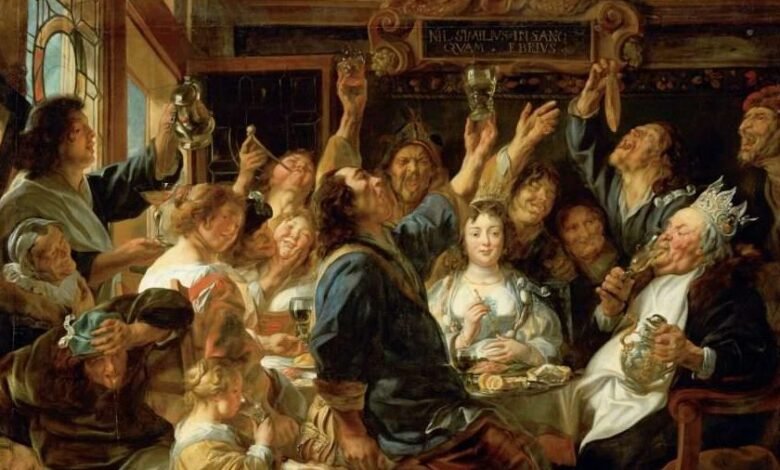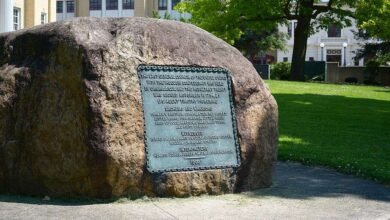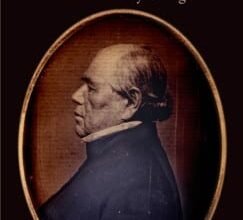The Taverns of Old New York


 The accomplished tavern-keeper of New York, as well as of London, knew how to welcome his guest and from long experience instinctively knew how to reach his heart. After receiving him with the most unbounded cordiality, occasionally dropping him a piece of news which he knew would interest him, or one of his newest jokes, he soon made him feel glad to be in his house.
The accomplished tavern-keeper of New York, as well as of London, knew how to welcome his guest and from long experience instinctively knew how to reach his heart. After receiving him with the most unbounded cordiality, occasionally dropping him a piece of news which he knew would interest him, or one of his newest jokes, he soon made him feel glad to be in his house.
When the dinner was ready he was on hand to place the first dish on the table and to give him his company if he saw that it was desirable.
In colonial times signs were extensively used. The hardware dealer placed above his door a sign of Crossed Daggers, or a Golden Handsaw, or a Golden Key; some used the sign of the Crossed Guns. A carriage-maker used the sign of the Gilded Wheel, a tailor that of the Hand and Shears.
Thus the business streets were filled with signs, and a well-known or prominent sign was invariably used as a landmark to designate locations of other houses.

 Tavern signs were much used in this way. Houses were not numbered, and in the low state of education, numbers as well as worded signs would have been of little use. Taverns obtained their names from the signs hung out; and the tavern sign had a wider range of diversity than that of any other business.
Tavern signs were much used in this way. Houses were not numbered, and in the low state of education, numbers as well as worded signs would have been of little use. Taverns obtained their names from the signs hung out; and the tavern sign had a wider range of diversity than that of any other business.
It was almost unlimited; but there were certain favorites. Sometimes tavern-keepers clung tenaciously to signs which they carried with them from place to place and the tavern-keeper of colonial times appears to have been a roving character.
Some features of tavern life and some of the taverns of New York were not to be commended. The eighteenth century was a period when hard drinking pervaded not only the American colonies but England as well.
Even preachers of the Gospel drank to excess. They were known to indulge at church meetings so as to lose control of both speech and gait. Unable to withstand the alluring temptations, they drank to excess without forfeiting the respect of their people.
The Reverend Jacob G. Green, of Morris County, New Jersey, although so pious that he would not allow any member of his family to converse on any but religious subjects on a Sunday, did not hesitate to engage in the business of manufacturing distilled liquor.
At funerals, as well as at weddings, wine and rum were consumed in excessive quantities, and it is a fact that persons were known to stagger in the funeral procession and at the brink of the grave. At the funeral of a colonial governor it is said that the minister’s nose glowed like a coal of fire, and the aged bearers staggered as they bore the coffin.

 The Reverend Samuel Melyen, pastor of the First Church of Elizabethtown, was obliged to give up his church on account of intemperance; but this did not seem to the people to be a warning example, for when his successor, Jonathan Dickinson, a young man of twenty-one, was installed, we are told that “great quantities of toddy was consumed.”
The Reverend Samuel Melyen, pastor of the First Church of Elizabethtown, was obliged to give up his church on account of intemperance; but this did not seem to the people to be a warning example, for when his successor, Jonathan Dickinson, a young man of twenty-one, was installed, we are told that “great quantities of toddy was consumed.”
When Philip Livingston died in 1749, funerals were held both at his Hudson River mansion and at his residence in Broad Street, New York. At each of these places a pipe of spiced rum was consumed [a “pipe” was a half “tun” barrel, about 125 gallons] and to the eight bearers were given gloves, mourning rings, scarfs, handkerchiefs and monkey spoons [a small spoon used mostly by the Dutch as memorial tokens of a wedding, or funeral].
When intemperance was looked upon with such indulgence it is hardly to be expected that the young and gay men of the period would exercise much restraint; and many a convivial party at the tavern ended in a drinking bout, and sometimes in a riot of drunkenness and debauchery.
A man in the condition which we of the present day would think quite drunk, and a proper subject for the care of his friends or relatives, was at that time considered to have taken only a proper modicum of drink. No man was looked upon as drunk until he was entirely down and out. The prevailing formula was:
“Not drunk is he who from the floor
Can rise again and still drink more,
But drunk is he who prostrate lies,
Without the power to drink or rise.”
In New England rum [made from molasses produced by slaves] was so extensively made that the price became as low as twenty-five cents per gallon. It was popularly called “Kill-devil.” In New Jersey large quantities of apple-jack were turned out, which, when new, was quite fiery, and this was called “Jersey lightning.”
Servants were not expected to be entirely free from the drinking habit, which, within certain bounds, was looked upon by their employers as pardonable.
Announcement was made in the New York Gazette and Weekly Mercury of December 4, 1769, that “An Hostler that gets drunk no more than 12 times in a year and will bring with him a good Recommendation, is wanted. Such person will meet with encouragement by applying to H. Gaine.”
Read more about taverns, bars and nightclubs in New York.
This essay was drawn from Old Taverns of New York by William Harrison Bayles, published by Frank Allaben Genealogical Company, 42nd Street, New York, NY, in 1915. It was annotated by John Warren.
Illustrations, from above: A tavern scene “Settling the Affairs of the Nation,” ca. 1766-1799, print by Richard Purcell; tavern sign of The Falcon, in Chester, England (from Fritz Endell’s Old Tavern Signs, 1916); and a detail from Jacob Jordaens’ “The Feast of the Bean King,” painted around 1640-1645 (Kunsthistorisches Museum, Vienna).
Source link




